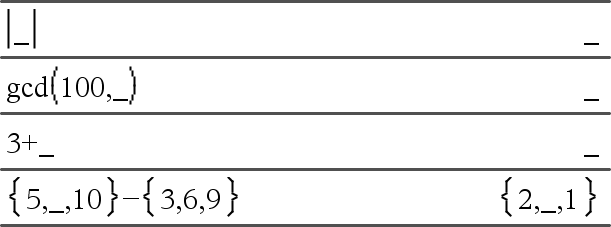Calculations involving void elements
The majority of calculations involving a void input will produce a void result. See special cases below.

When analyzing real-world data, you might not always have a complete data set. TI‑Nspire™
You can find an example of data involving empty elements in the Lists & Spreadsheet chapter, under “Graphing spreadsheet data.”
The delVoid() function lets you remove empty elements from a list. The isVoid() function lets you test for an empty element. For details, see delVoid(), here, and isVoid(), here.
Note: To enter an empty element manually in a math expression, type “_” or the keyword void. The keyword void is automatically converted to a “_” symbol when the expression is evaluated. To type “_” on the handheld, press / _.
|
Calculations involving void elements |
|
|
The majority of calculations involving a void input will produce a void result. See special cases below. |
|
|
List arguments containing void elements |
|
|
The following functions and commands ignore (skip) void elements found in list arguments. count, countIf, cumulativeSum, freqTable►list, frequency, max, mean, median, product, stDevPop, stDevSamp, sum, sumIf, varPop, and varSamp, as well as regression calculations, OneVar, TwoVar, and FiveNumSummary statistics, confidence intervals, and stat tests
|
|
|
SortA and SortD move all void elements within the first argument to the bottom.
|
|
|
In regressions, a void in an X or Y list introduces a void for the corresponding element of the residual. |
|
|
An omitted category in regressions introduces a void for the corresponding element of the residual. |
|
|
A frequency of 0 in regressions introduces a void for the corresponding element of the residual. |
|